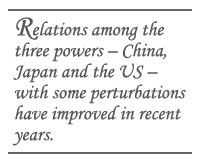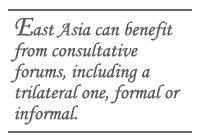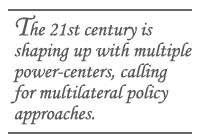The Globe’s Most Important Relationship
The Globe’s Most Important Relationship

WASHINGTON: Together China, Japan and the US are today’s most important trilateral relationship. Regional and global economic integration – along with increasing openness, mobility and democratization – is currently shaping US-Chinese-Japanese relations. Only domestic politics or virulent nationalism could disrupt what promises to be a positive new decade for great-power relations in East Asia.
The three countries are not in an expansive mood:
● China still grows rapidly, deriving significant clout and thereby assuming a new world role. Despite a recent leadership transition, Chinese leaders remain preoccupied with mitigating massive distortions of growth, ensuring a successful Olympics and preventing regime change. Its military modernization arouses American angst and some regional hedging, and its international engagement has moved beyond the Asian platform. Yet China continues to be out of step with the political morality of leading countries and shows increasing heartburn with international badgering. China has a long way to go in exercising international leadership.
● The next US president, scheduled to take office early 2009, will probably inherit at least two wars, both continuing to drain high-level attention and resources, contributing to polarization and declining government capabilities. Restoring American attention to the region, particularly Southeast Asia, could be difficult. Both Republican and Democrat candidates and their foreign-policy gurus maintain 20th-century rhetoric, enamored with US global leadership. Not recognizing the profundity of change, the US obsesses on China’s rise, oblivious to American impact on others. Its present economic downturn adds new complexity to America’s influence and global role.

● Japan remains a major world economic player, but its economy lacks dynamism. Slow to define a comfortable global role for itself, Japan wants to be a “normal” nation without its postwar defense limitations. But it has not achieved that status. Japan remains fearful of China’s competition even as both economies become more entwined. Japan and China have one major concrete dispute – maritime claims. The US and Japan each value their alliance, but generally the US takes Japan for granted. The US would like to see greater Japanese influence in Southeast Asia – the absence of which was clear when most East Asian nations did not support Japan’s efforts to win a permanent UN Security Council seat.
Relations among the three powers, with some perturbations – e.g., the current fracas over US military vessels visiting Hong Kong – have improved in recent years. Whatever political problems arising from trade, substantial Sino-American cooperation has emerged on key issues with productive dialogue underway. US-Japanese ties intensified during the Koizumi era, but have some current hiccups raised by the Liberal Democratic Party’s diminishing clout. Most important, Sino-Japanese tensions have diminished, trade grows rapidly, high-level visits have resumed and both countries recognize the need to check nationalist forces despite territorial differences. Still, China and Japan lack serious dialogue.
In the much-heralded Six Party Talks on the North Korean nuclear issue, China provided useful leadership, and the Bush administration did an about-face, resurrecting Clinton’s pragmatic policy of bribery. Yet, the verdict on these talks is not in – and depends on verification of North Korea’s holdings of nuclear material.

Washington largely views East Asia through a strategic and military lens. The US remains a central pillar in Northeast Asia security, and most Asian countries welcome its presence as a balancing factor. From a policy standpoint, continuing US preoccupation with China’s growth and modernization obscures China’s rapid integration with East Asia, the rise of more independent powers with growing confidence and the notion of an East Asian ethos.
Despite the US central role in the region, particularly in Northeast Asia, any US policy must start with the recognition that its influence has declined – a positive consequence of the rise of Asian economies. Asian nations are not only economic competitors, but also the home of American multinationals. So relations naturally are more balanced. Diffusion of power requires the US to focus on its competitive prowess while dealing with Asia in a give-and-take way on issues like energy and East Asia’s economic integration.
North Korea and China, two ongoing security problems on which the US military structure in East Asia is based, are also changing, both on a trajectory toward some better resolution:
● In the final days of Chen Shui-Bian’s premiership, we may witness the last big stirrings of Taiwanese assertionism. However, despite increasing military buildups, with Taiwan the major focus of the People’s Liberation Army, the threat of a unilateral declaration of independence has diminished along with the threat of war. Cool heads on both sides of the strait increasingly recognize the necessity to manage the conflict through negotiations and normal economic workings, not confrontation. The potential destabilizing element is domestic politics, in the US, China or Taiwan, as leadership changes. Despite domestic political rumblings, strategic clarity dominates US policy toward Taiwan – keep it frozen until Beijing and Taipei sort the matter out themselves.

● Predictions about North Korea, with its opaqueness and uncertain leadership transition, require more caution. Recognizing that its survival depends on change, North Korea is slowly becoming addicted to South Korean largesse, Chinese trade and investment, and more contact with the world. The immediate uncertainty is North Korea’s denuclearization; if that ends badly, the climate will again change, but not necessarily toward hostilities.
The security focus should be reducing Sino-American and particularly Sino-Japanese tensions and searching for frameworks of continued cooperation. Continued globalization of trade, finance and culture help, but also produces discontents and economic nationalism. Thus leadership, as the Bush administration has provided against congressional protectionism, is key. Additional steps that might contribute to better trilateral relationships include:
● The US and Japan should not pursue an “alliance of values” with Australia and India, largely an amorphous anti-Chinese move that does little to deter China or improve regional security.
● On the other side, Japan deserves to be a permanent member of the Security Council, and China should end its opposition. Such a Chinese move—unfortunately unlikely in the near future – could change the climate in East Asia and the world.
● East Asia can benefit from consultative forums, including a trilateral one, formal or informal. This idea, long favored by non-governmental organizations, is rejected by China because of the US-Japan alliance, with possible complaints from other countries and skepticism from all as to its worth. But with relations sufficiently developed, such a forum could, for example, be an offshoot of the G-8 meeting, of which China should soon be a regular member. China, Japan and the US have plenty to talk about besides North Korea.

● Efforts toward deeper, more formal East Asia economic and political integration have lagged due to the complexity and Sino-Japanese rivalry on how to organize the region. Unless these powers – like Germany and France in Europe – find an accommodation, the project will stumble along. The US, largely absent from this debate, is apparently still addicted to Asia-Pacific Economic Cooperation, which is becoming, but doesn’t have to be, a vehicle for diluting East Asian cooperation. Movement toward an East Asian economic community, not a Pacific one, offers the best vehicle for peaceful security structure in East Asia.
The last part of the 20th century was dominated by dualities like the Cold War. The 21st century is shaping up with multiple power-centers, calling for multilateral policy approaches.
China, Japan, US – and throw India and Russia into the mix: Asia quickly becomes ground-zero for great power relations in the decades to come. Let’s hope consultation and integration win the day.
Morton Abramowitz is a senior fellow at the Century Foundation. His book with Stephen Bosworth, “Chasing the Sun – Rethinking East Asia Policy,” was published in 2006 by the Century Foundation Press. Click here for an excerpt from the book.